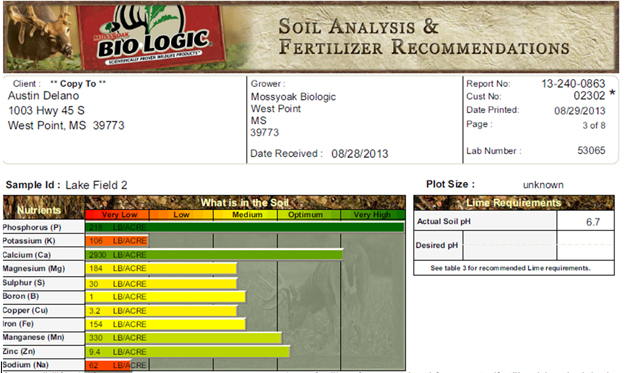
Fertilizer and lime recommendations can be confusing. All the different numbers and suggestions can really make it difficult to understand what your soil and crop needs to perform its best. Let’s simplify things with a few quick tips to understanding your soil sample.
- Soil pH is the first thing you need to get right. Although some crops are more tolerant of acidic soils than others, your plot will perform best with a pH of 6.5-7.0. Lime is relatively inexpensive and is the key to successful plots. For perspective, a plot with a pH of 5.5 is 100 times more acidic than one at 6.5. Over 50 percent of fertilizer added to a plot with a 5.5 pH is wasted because it is not able to be used by the plants. 1-2 tons per acre of ag lime is very common to get your plots where they need to be.
- Remember that the 3 numbers on bagged fertilizer (N-P-K) are based off of 100 pounds, not 50. In a 50-pound bag of 13-13-13, there are 6.5 pounds or units each of actual nitrogen, phosphorous, and potassium. If your sample says you need 40 pounds each of N-P-K, you would need 350 pounds per acre of 13-13-13. This would give you 45.5 pounds of N-P-K.
- An advanced soil test is needed to get current levels of micro nutrients like copper, iron, zinc, boron, etc. These micros are usually not present in bagged fertilizer. Although they are needed in very small amounts in comparison to the macros (N-P-K), it can be worthwhile to do an advanced sample every 3-4 years and keep the micros up to date.
- As a general rule of thumb, cereal grains, corn, and brassicas are nitrogen lovers. Legumes such as clovers, peas, beans, or alfalfa fix their own nitrogen from the atmosphere and need very little at planting time. For example, once established, clover can be fertilized with a common 0-20-20. At planting time, a low nitrogen blend like 5-20-20 can be used to give the young clover a small dose of nitrogen while it develops a root system and begins to affix its own from the air. On the other end of the spectrum, corn can use 100-200 pounds of nitrogen per acre for maximum yield.






























